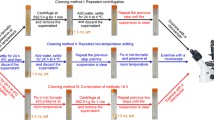Abstract
Nematode density and taxonomic composition from Dry Valley soil processed by the sugar centrifugation (SC) method in Antarctica was compared to those extracted from soils shipped frozen to the USA and processed by either the SC or Baermann Funnel (BF) (at 5°C and 10°C) techniques. Soil selected for the extraction comparisons represented a wide range of soil properties found in the Dry Valleys. More nematodes were recovered from freshly collected Antarctic soil and from stored frozen soil using the SC technique than from BF at either temperature (P<0.05). Temperature had no effect on nematode densities extracted by the BF. Scottnema lindsayae was the most abundant species recovered by all extraction methods, but recovery was significantly lower from stored soils. Thus, nematodes can be extracted qualitatively following frozen storage using SC, but quantitative studies of nematode populations should be based on soils extracted following field sampling.
Similar content being viewed by others
References
Baermann G (1917) Eine einfache Methode zur Auffindung von Ankylostomum (Nematoden) Larven in Erdproben. Geneesk Tijdschr Ned-Indie 57:131–137
Barker KR (1985) Nematode extraction and bioassays. In: Barker KR, Carter CC, Sasser JN (eds) An advanced treatise on Meloidogyne, vol II, Methodology. North Carolina State Univ Graphics, Raleigh NC, pp 19–35
Bunt JS (1954) The soil inhabiting nematodes of Macquaire Island. Austr J Zool 2:264–274
Caldwell JR (1981) Biomass and respiration of nematode populaions in two moss communities at Signy Island maritime. Antarctica. Oikos 37:160–166
Campbell IB, Claridge GGC (1987) Antarctica: soils, weathering processes and environment. Elsevier, New York 368 pp
Fitzsimmons JM (1971) On the food habits of certain antarctic arthropods from coastal Victoria Land and adjacent islands. Pacific Insects Monogr 25:121–125
Freckman DW, Virginia RA (1990) Nematode ecology of Antarctic Dry Valley ecosystems. Ant J US 25:229–230
Freckman DW, Mankau R, Ferris H (1975) Nematode community structure in desert soils: nematode recovery. J Nematol 7:343–346
Gee GW, Bauder JW (1986) Particle-size analysis. In: Page AL, Miller RH, Keeney DR (eds) Methods of soil analysis. Chemical and microbiological properties. Agron 9, Am Soc Agron, Madison, WI, pp 383–411
Huhta V, Setala H (1990) Laboratory design to simulate complexity of forest floor. Biol Pert Soils 10:155–162
Jenkins WR (1964) A rapid centrifugal flotation technique for extracting nematodes from soil. Plant Dis Rept 48:692
Maslen NR (1981) The Signy Island terrestrial reference sites: XII. Population ecology of nematodes with additions to the fauna. Br Antarct Surv Bull 53:57–75
Nelson DW, Somers LE (1982) Total carbon organic carbon and organic matter. In: Page AL (ed) Methods of soil analysis, Part 2. Chemical and Microbiological Properties. 2nd edition, Amer Soc Agron, Madison WI, pp 539–579
Overhoff A, Freckman DW, Virginia RA (1993) Life cycle of the microbivorous Antarctic Dry Valley nematode Scottnema lindsaye (Timm 1971). Polar Biol 13:151–156
Pickup J (1990a) Seasonal variation in the cold-hardiness of a free-living predatory Antarctic nematode, Coomansus gerlachei (Mononchidae). Polar Biol 10:307–315
Pickup J (1990b) Strategies of cold-hardiness in three species of Antarctic dorylaimid nematodes. J Comp Physiol B 160:167–173
Pickup J, Rothery P (1991) Water-loss and anhydrobiotic survival in nematodes of Antarctic fellfields. Oikos 61:379–388
Spaull VW (1973) Qualitative and quantitative distribution of soil nematodes of Signy Island, South Orkney Islands. Br Antarct Surv Bull 33:177–184
Timm RW (1971) Antarctic soil and freshwater nematodes from the McMurdo Sound region. Proc Helminth Soc Wash 38:42–52
Viglierchio DR, Schmitt RV (1983) On the methodology of nematode extraction from field samples: comparison of methods for soil extraction. J Nematol 15:450–454
Vincent WF (1988) Microbial ecosystems of Antarctica. Cambridge Univ Press, New York 304 pp
Wharton DA, Brown IM (1989) A survey of terrestrial nematodes from the McMurdo Sound region, Antarctica. NZJ Zool 16:467–470
Wharton DA, Brown IM (1991) Cold-tolerance mechanisms of the Antarctic nematode Panagrolaimus davidi. J Expt Biol 155:629–641
Whitehead AG, Hemming JR (1965) A comparison of some quantitative methods of extracting small vermiform nematodes from soil. Ann Appl Biol 55:25–38
Yeates GW (1970) Terrestrial nematodes from the Bunger Hills and Gaussberg Antarctica. NZJ Zool 6:641–643
Author information
Authors and Affiliations
Rights and permissions
About this article
Cite this article
Freckman, D.W., Virginia, R.A. Extraction of nematodes from Dry Valley Antarctic soils. Polar Biol 13, 483–487 (1993). https://doi.org/10.1007/BF00233139
Received:
Accepted:
Issue Date:
DOI: https://doi.org/10.1007/BF00233139




